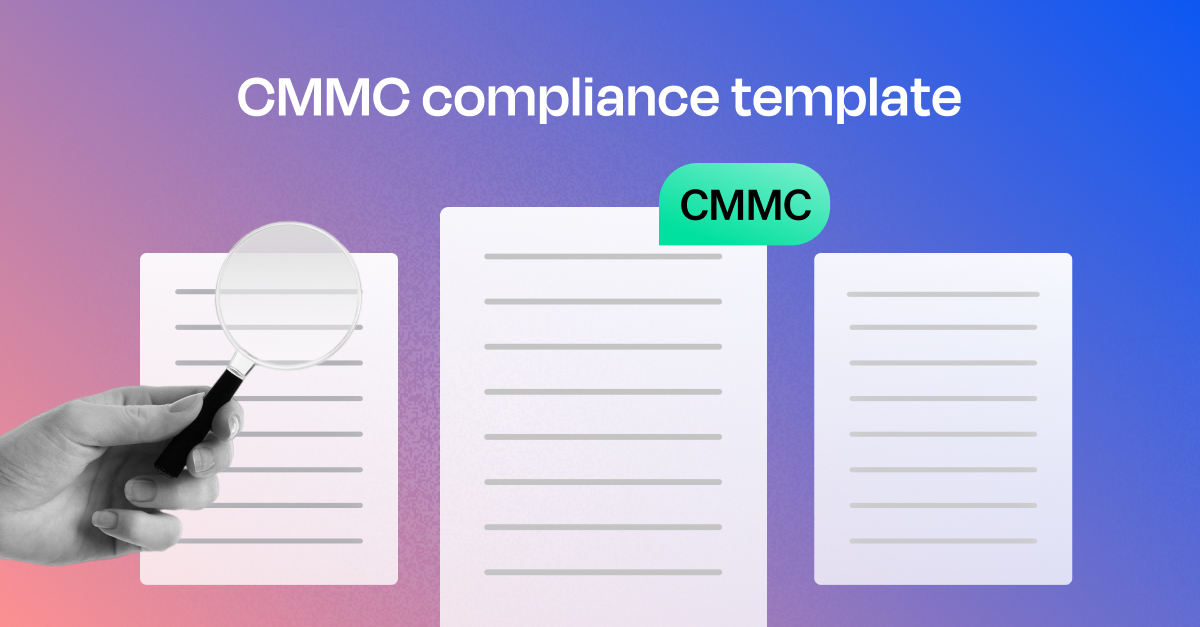CMMC Compliance Templates [Download Free Policies]
Anwita
Jan 21, 2025
The Cybersecurity Maturity Model Certification (CMMC) is one of the most stringent models for conducting security assessments. Its detailed documentation requirement may feel complex and overwhelming, especially to small contractors. This is because writing policies from scratch is one of the most time-intensive, confusing, and manual work-heavy tasks.
This is where pre-built CMMC compliance templates come in. You can use these standardized, customized templates to start your compliance journey. This way, you can significantly reduce the time and effort required to reach the finish line of CMMC compliance.
What are CMMC policies?
CMMC has three levels of certification. If you are undergoing assessment for Level 2 and above, your systems must comply with 110 security requirements mandated in NIST 800 171. These requirements fall within the 14 control families:
- Access controls
- Awareness and training
- Audit and accountability
- Configuration management
- Identification and authentication
- Incident response
- Maintenance
- Media protection
- Physical protection
- Personnel security
- Risk assessment
- Security assessment
- System and communications protection
- System and information integrity
Free CMMC policy templates
As we mentioned before, CMMC has around 100 controls aligned with NIST. You need to develop policies as per the NIST controls to adhere to all relevant standards.
Compliance policies are a set of rules and guidelines that an organization establishes to ensure it adheres to all relevant security and privacy standards to mitigate risks and avoid legal issues.
We have listed some of the policy templates for CMMC below. You can download and customize them as per your needs.
1. Control ID – AC.L1-3.1.1 Authorized Access Control
Only allow authorized users, their processes, or approved devices to access your information systems. Prevent non-privileged users from performing high-level functions and log any such attempts or activities.
Download Your Access Control Policy
2. Control ID – AC.L2-3.1.5 Least Privilege and AC.L2-3.1.7 Privileged Functions
Track, document, and report security incidents to designated officials, both within your organization and external authorities as needed.
Download Your Privacy By Design Policy
3. Control ID – IR.L2-3.6.2 Incident Reporting
Track, document, and report incidents to designated officials and/or authorities both internal and external to the organization.
Download Your Incident Management Policy
4. Control ID – MP.L1-3.8.3 Media Disposal
Properly sanitize or destroy media containing Federal Contract Information before disposal or reuse.
Download Your Media Disposal Policy
5. Control ID – MP.L2-3.8.6 Portable Storage Encryption
Use cryptography to secure the confidentiality of Controlled Unclassified Information (CUI) stored on digital media during transport unless alternative physical safeguards are in place.
Download Your Encryption Policy
6. Control ID – PE.L1-3.10.5 Manage Physical Access
Control and manage access to physical systems by securing access devices like badges and keys.
Download Your Physical and Environmental Security Policy
7. Control ID – RA.L2-3.11.1 Risk Assessments
Regularly assess risks to your operations, systems, and reputation caused by the handling, storage, or transmission of CUI.
Download Your Risk Assessment & Management Policy.
8. Control ID – SC.L2-3.13.6 Network Communication by Exception
Set up your network to block all traffic by default and only permit communication based on specific exceptions.
Download Your Communications and Network Security Policy
9. Control ID – SC.L2-3.13.8 Data in Transit
Use cryptographic protections to safeguard CUI during transmission unless you have other physical protections in place.
Download Your Data Protection Policy
Now that you’ve explored our CMMC compliance templates, here’s a streamlined strategy to achieve full compliance:
Your all-in-one policy management tool
Policies are essential for every compliance standard—they are often crafted to help the organization align with specific requirements and recommendations. Sprinto simplifies this process by providing templates that address common compliance needs, helping IT leaders avoid the hassle of drafting policies from scratch.
- Navigate to the policies section to publish a policy document using a built-in template, draft your own, or upload an existing policy. You can choose from default policies or create custom ones.
- Define the policy’s applicability (who it applies to), assign a policy owner, set review/update triggers, and maintain updated versions.
- Ensure policies are owned and approved by the relevant individuals or admins before publishing.
- Tag policies to compliance standards like SOC 2, ISO, or others. One policy links to multiple standards.
- Use the Sprinto platform to make policies accessible to the organization and teams, and request acknowledgment directly within the platform. This eliminates the need for additional tools.
- Sprinto logs acknowledgment evidence, which is shared during audits to demonstrate that everyone in the organization has endorsed and accepted the policies.
Talk to our experts to discuss how we can ease your CMMC journey.


Use Sprinto to centralize security compliance management – so nothing
gets in the way of your moving up and winning big.





















